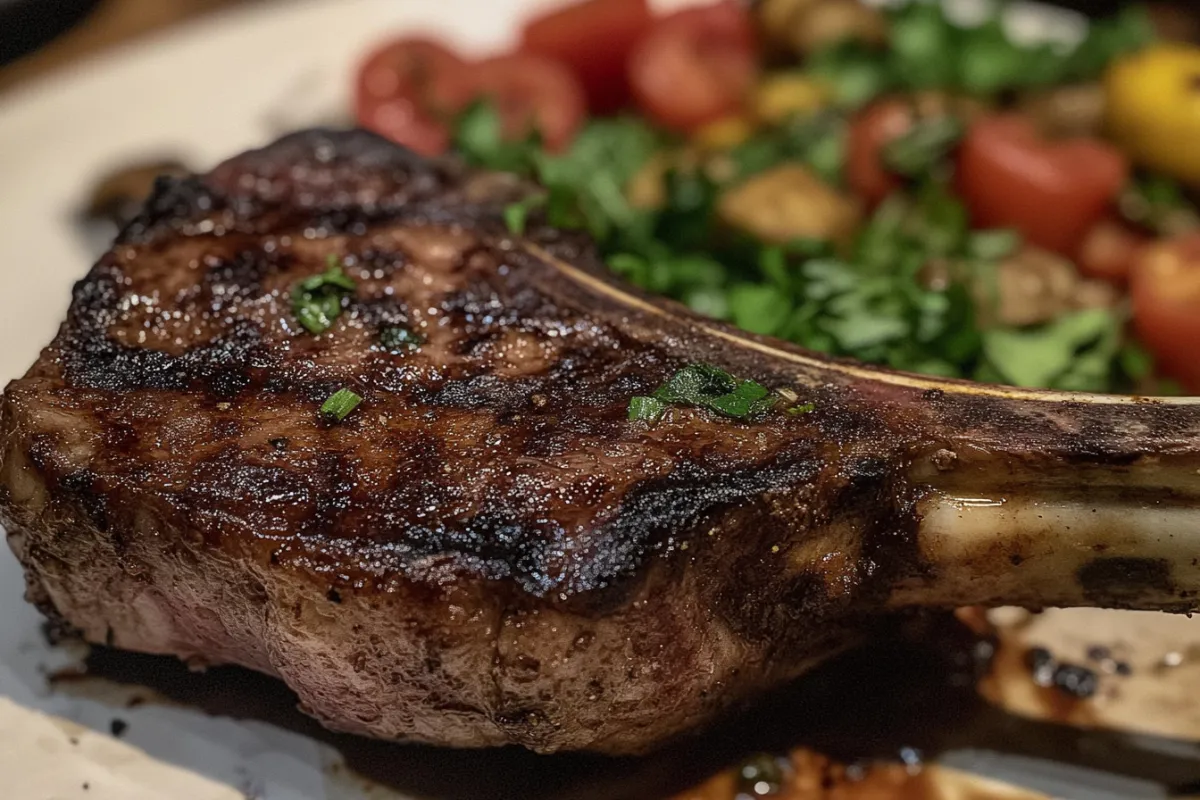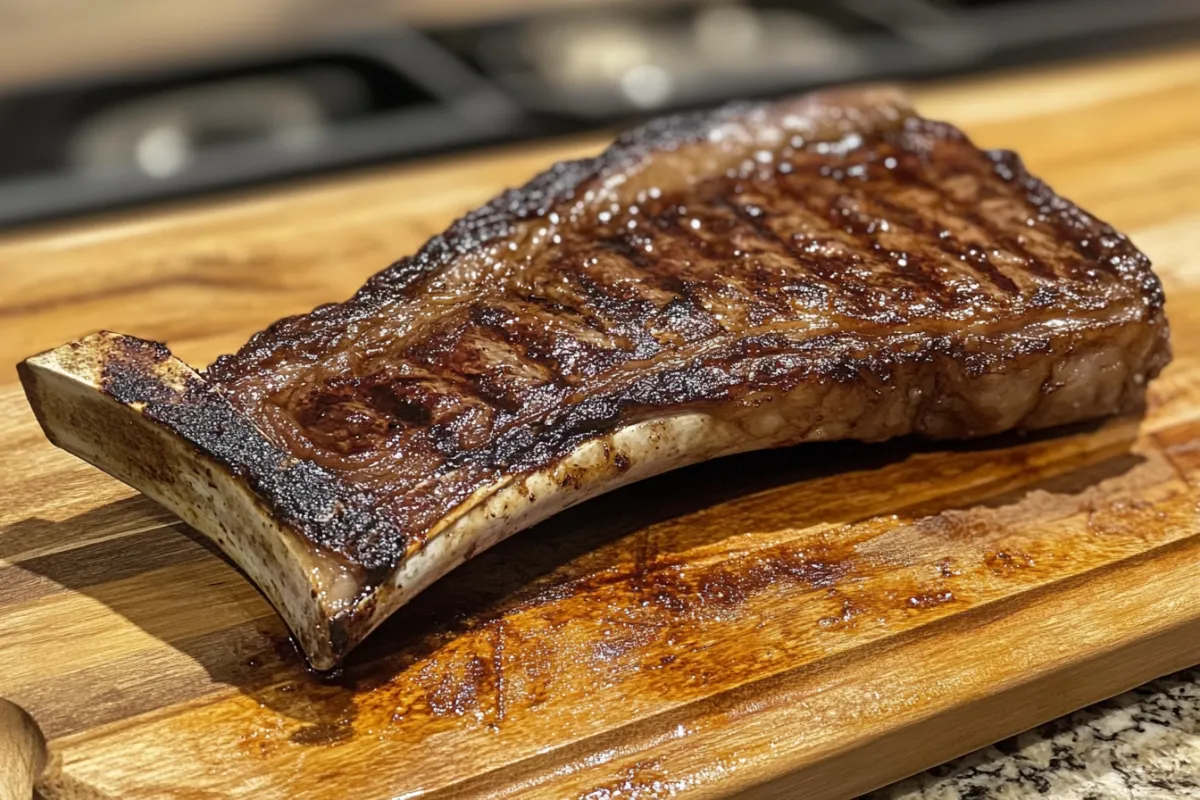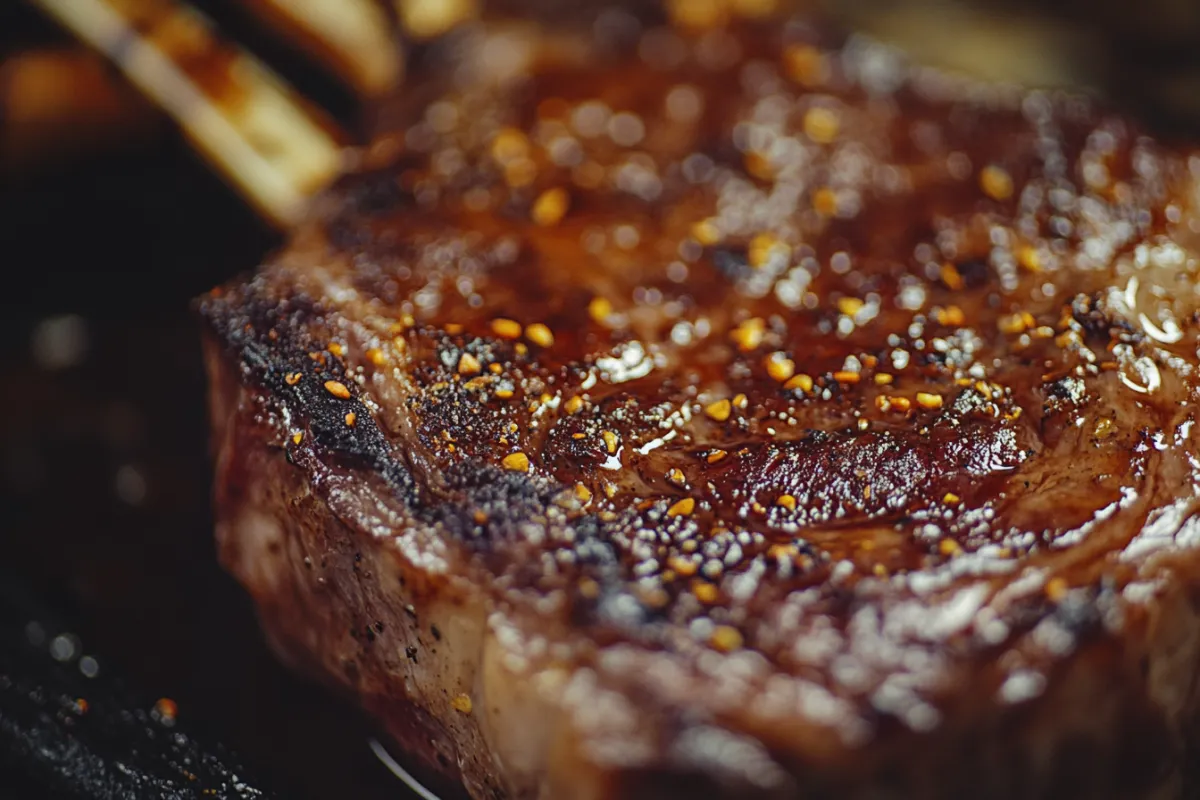If you’re a steak lover or have dined at a high-end restaurant, chances are you’ve heard of the tomahawk steak. This impressive cut of meat is known for its unique presentation, often served with an extra-long rib bone that makes it visually stunning. But beyond aesthetics, what makes a tomahawk steak stand out from other cuts? In this comprehensive guide, we’ll dive deep into what cut of steak is a tomahawk, how it’s different from other steaks, and why it’s so popular among steak enthusiasts.

What is a Tomahawk Steak?
At its core, the tomahawk steak is essentially a bone-in ribeye steak with a large portion of the rib bone left intact. This bone is “frenched,” meaning the meat and fat are scraped clean to give it a tomahawk axe-like appearance, which is where the steak gets its name. The tomahawk steak is prized not only for its large size but also for its rich marbling, which gives it an exceptionally buttery texture and robust flavor when cooked.
For a deeper dive into cooking and enjoying this steak, this ultimate guide to cooking tomahawk steak provides detailed instructions on how to grill, pan-sear, and oven-finish this impressive cut.
Anatomy of a Tomahawk Steak
The tomahawk steak is cut from the rib section of the cow, specifically between the 6th and 12th ribs. This area, known as the beef rib primal, produces some of the most flavorful steaks due to the high amount of intramuscular fat (also known as marbling). The attached rib bone can be as long as 20 inches, adding to the steak’s dramatic presentation.
For a more detailed breakdown of the tomahawk steak’s anatomy, check out this guide from Omaha Steaks on the tomahawk steak cut.
The Difference Between Tomahawk and Ribeye
You might be wondering, if a tomahawk steak is just a bone-in ribeye, what makes it different from a standard ribeye? The primary distinction lies in the presentation. While both cuts are technically from the same part of the cow, a tomahawk steak leaves the entire rib bone intact, whereas a ribeye typically has the bone removed or trimmed significantly.
A tomahawk steak can also weigh significantly more than a ribeye, with some steaks tipping the scales at up to three pounds! The additional bone doesn’t contribute to the meat’s flavor but adds to the steak’s overall visual appeal, making it perfect for a special occasion or a night of impressive grilling.
According to Beef It’s What’s For Dinner, the tomahawk steak is sometimes called a Cowboy Ribeye when the bone is frenched, but with the full rib bone attached, it’s known as a tomahawk.
Why is the Tomahawk Steak Expensive?
If you’ve ever glanced at the price tag of a tomahawk steak, you’ve probably noticed it’s far more expensive than a typical ribeye. Why? A large part of the cost comes from the presentation. The extra-long bone is purely aesthetic, but it requires additional work from the butcher to trim it correctly, which adds to the price. Furthermore, tomahawk steaks are usually taken from the highest-quality part of the rib section, where the marbling is most pronounced.
Other factors contributing to the price of a tomahawk steak include:
- Size: The tomahawk is a massive cut of meat, often weighing up to 3 pounds, which means you’re paying for a large quantity of high-quality beef.
- Marbling: The intense marbling of the steak means it is tender, juicy, and rich in flavor, qualities that are highly sought after by steak lovers.
- Bone Handling: Butchers spend extra time “frenching” the bone, which adds to the labor costs, reflected in the steak’s price.
Looking to try a gourmet meal? Check out this Crab Brulee Recipe, a perfect accompaniment to a fancy steak dinner.
Tomahawk Steak vs Cowboy Ribeye
It’s common for people to confuse the tomahawk steak with the cowboy ribeye, but there are a few key differences. Both cuts are ribeye steaks, but the main distinction is the length of the rib bone. The cowboy ribeye has a much shorter frenched bone, typically around 5-6 inches, whereas the tomahawk’s bone can extend up to 20 inches. This difference in size makes the tomahawk steak much more visually impressive, which is why it’s often chosen for high-end presentations.
History of the Tomahawk Steak
The tomahawk steak is a relatively recent addition to the world of gourmet beef, but it has quickly become a favorite among steak lovers. Historically, large bone-in ribeye steaks were served primarily in rustic settings like steakhouses and barbecue joints. However, the tomahawk steak has its roots in French butchery, where the practice of “frenching” a bone became popular for aesthetic reasons. Over time, this technique made its way to high-end restaurants and soon became a hallmark of luxury dining.
How to Cook the Perfect Tomahawk Steak
Cooking a tomahawk steak requires some technique, but it’s not as complicated as it might seem. Because of its size, the tomahawk steak benefits from a method that allows for even cooking throughout the thick cut.

Step-by-Step Guide
Here’s how to cook the perfect tomahawk steak:
- Preheat Your Grill or Oven: Heat your grill to high or preheat your oven to 400°F.
- Season the Steak: Generously season the steak with coarse salt and pepper. You can also add garlic powder, rosemary, or thyme for extra flavor.
- Sear the Steak: On a hot grill or in a cast iron skillet, sear the steak for 3-4 minutes on each side until a golden-brown crust forms.
- Finish in the Oven or Grill: If grilling, move the steak to the cooler side and cook it to your desired doneness. If using an oven, place the steak in and cook for an additional 10-15 minutes, depending on thickness.
- Rest the Steak: Remove the steak from the heat and let it rest for 5-10 minutes before slicing.
The tomahawk steak is best served medium-rare to medium for optimal flavor and tenderness. For detailed instructions on grilling techniques, Spruce Eats provides a great recipe for the perfect tomahawk steak.
Best Side Dishes to Serve with Tomahawk Steak
A rich and flavorful tomahawk steak deserves equally delicious side dishes. Here are some perfect pairings:
- Mashed Potatoes: A classic and creamy side that complements the juicy steak.
- Grilled Vegetables: Zucchini, bell peppers, and asparagus pair beautifully with the charred flavors of a grilled steak.
- Roasted Garlic: Roasted garlic provides a sweet, earthy contrast to the buttery richness of the steak.
Nutritional Information and Health Considerations
While the tomahawk steak is undeniably delicious, it’s also a calorie-dense cut of meat. A typical tomahawk steak can range from 1,200 to 1,800 calories, depending on its size and how it’s cooked. Here’s a breakdown of the nutrients in a standard 16-ounce tomahawk steak:
- Calories: 1,300
- Protein: 90 grams
- Fat: 100 grams
- Saturated Fat: 40 grams
It’s important to enjoy this steak in moderation, especially if you’re watching your caloric intake or have dietary restrictions.
Tomahawk Steak Serving Tips
Presentation is a key element of serving a tomahawk steak. Its unique bone structure adds drama to the plate, making it perfect for special occasions or high-end dinners. Here are some tips to make the most of your tomahawk steak when serving:
Slicing the Steak
After the steak has rested for a few minutes, it’s time to slice it for serving. The best way to carve a tomahawk steak is to cut the meat away from the bone first. Then, slice the steak into even, 1/2-inch thick slices against the grain. Slicing against the grain helps maintain tenderness and ensures a juicy bite every time.
Presentation Ideas
- Leave the Bone Attached: For a more dramatic presentation, consider leaving the bone attached and serving the entire steak on a large cutting board or platter. This makes for a great visual centerpiece at the table.
- Serve Family-Style: Alternatively, you can slice the steak and arrange the slices neatly on a serving platter. Garnish with fresh rosemary or thyme for an added touch of elegance.
Finishing Touches
Before serving, consider adding a pat of compound butter (herb butter) on top of the steak for extra richness. You can also drizzle a bit of high-quality olive oil or sprinkle flaky sea salt for added flavor and texture.
Pairing with Wine
The tomahawk steak’s rich, fatty texture pairs beautifully with bold red wines. Consider serving your steak with a glass of Cabernet Sauvignon, Zinfandel, or Malbec to complement the meat’s flavors.
By following these tips, you can elevate your tomahawk steak from just a delicious meal to an unforgettable dining experience.

FAQs About Tomahawk Steak
Here are some of the most frequently asked questions about tomahawk steak:
Is a Tomahawk Steak the Same as a Ribeye?
Yes, a tomahawk steak is a type of ribeye steak, but it has an extra-long frenched bone, which makes it visually unique.
Why Does the Tomahawk Steak Have Such a Long Bone?
The long bone in a tomahawk steak is left intact primarily for presentation. It doesn’t affect the flavor or texture of the meat.
How Much Does a Tomahawk Steak Weigh?
A typical tomahawk steak can weigh between 1.5 and 3 pounds, depending on how much of the rib bone is included.
How Should You Store Leftover Tomahawk Steak?
Store leftover tomahawk steak in an airtight container in the refrigerator for up to 3 days. You can also freeze it for longer storage.
Is Tomahawk Steak Worth the Price?
For many, the experience of eating a beautifully presented tomahawk steak is worth the price. However, if you’re just looking for flavor, a regular ribeye might be a more cost-effective option.
Conclusion
Its slow-roasting method brings out the flavors, and it provides a generous amount of meat to go around.
On the other hand, the tomahawk steak delivers a unique dining experience, with its impressive presentation and bold flavors. Its long frenched bone and large size make it a showstopper, perfect for upscale dinners or when you want to make a statement with your cooking. The high marbling and intense flavor profile of the tomahawk offer an indulgent steak experience like no other.
Ultimately, your choice comes down to the occasion and your personal preference. Whether you’re looking for a grand roast with prime rib or an eye-catching steak with the tomahawk, you can’t go wrong with either option. Both cuts deliver in terms of taste, texture, and quality, making them worth trying at least once in your culinary adventures.

